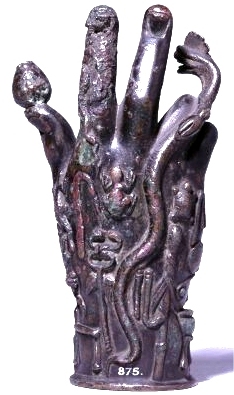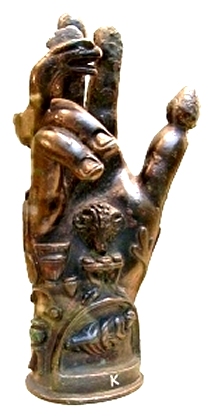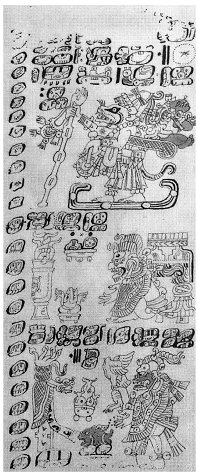Alien Nummo and Hand
and Foot Symbols Part II
Updated June 2023

Back of Bronze Handhttps://www.tumblr.com/ search/hand+of+sabazius
Hand and Foot symbols appear in many ancient cultures, which I associate with the Dogon religion. The alien Nummo didn't have hands and feet like humans so depictions of hands and feet were used in the religion as genetic symbols identifying the Nummo and Nummo AncestorsShannon Dorey, Day of the Fish 146
The bronze hand above was used in the worship of Sabazius, a god of Thracian or Phrygian (Ancient Turkey) origin, who became popular in the Roman Empire.http://en.wikipedia.org/ wiki/Sabazios
A turtle and frog image appear on the back of the hand. Frogs are amphibians like the Nummo and my research indicates they were a symbol of the Nummo in many ancient religions including the Goddess religion of Old Europe.
The Greek goddess Artemis was worshiped as a toad in Egypt, Italy, and Lithuania and according to Marija Gimbutas, Sheela Na gig, a figure which has been found incorporated into old churches in medieval Ireland and England was none other than the ancient frog or toad goddess, the birth giver and regeneratrix inherited from the Neolithic.Shannon Dorey, Day of the Fish p.44 The Nummo were hermaphrodites but associated with the divine feminine and a breast appears on the frog in this image.
The Hogon and the heads of families kept a tortoise in their homes as the "guardian of the world" and gave it a bit of their food before meals.Shannon Dorey, The Nummo p.145 The turtle appears in the myths of many ancient cultures including those from North American Indigenous peoples, who refer to North America as turtle island.Shannon Dorey, The Nummo p.244
On the back of Sabazius' bronze hand, shown above, is a caduceus symbol, an ancient symbol which I associate with DNA. There is also a hook, which likewise appeared on the Dogon shrines and was identified with the Smith's hook and the stolen fire. The stolen fire was associated with the stolen DNA and our lost immortality.
A key event in the Dogon relgion was the regeneration of the Jackal to create Lébé, who was considered the mother of modern day humans. A wooden 'hand' of sene, the Acacia Faidherbia albida tree, was used by diviners and was known as the hind paw of the Jackal. The Nummo's failed experiment not only affected humans, which is represented by the Jackal, but all plant life, which is what the wooden 'hand' of the sene tree represented.Shannon Dorey, Day of the Fish p. 151
Lébé was born as a hermaphrodite but five generations after her/his birth, humans were born single-sexed. When the Nummo Ancestor Lébé was regenerated, Ogotemmêli said that the Nummo's womb had transformed Lébé's "bones into coloured stones, and ejected them into the bottom of the tomb so as to form the outline of a skeleton laid out flat on its back in the place where the body had been, with its head to the north."
The dougué stones, which were vomitted forth from the Seventh Ancestor (the Mistress/Master of Speech) and laid out in the outline of a stretched out body, marked the joints of the pelvis and shoulders and where the limbs were attached. Lébé's soul was incorporated into the stones that became the regenerated body.Shannon Dorey, Day of the Fish p. 308
Like the Dogon Lébé, the Egyptian Osiris was born from the mouth of a serpent. 'Osiris entered the tail of a great serpent, was drawn through its body, came out through its mouth, and was then born anew.'"Shannon Dorey, The Master of Speech p.213

Bronze hand 1st-2nd century CE.http://en.wikipedia.org/wiki/ Sabazios#mediaviewer /File:HandOfSabazius.JPG Author: Mike Young Located at the British Museum
The figure on the bottom of the front of the bronze hand appears to be inside an omphalos stone wrapped around with a cord. During the process when humans were created and regenerated, the individual being regenerated would be wrapped around with what the Dogon referred to as the "Cord of God". According to the Dogon, during the regeneration process the soul was transferred into the newly created body and the "Cord of God" became the new body's backbone.Shannon Dorey, The Rose p. 370

Cord of God? by Ji-Ellehttp://commons.wikimedia.org/wiki/ File:B%C3%A2ton_de_voleur_rituel_ Dogon-Mus%C3%A9e_barrois.jpg
This Dogon wooden carving, which is displayed in the Museum Barrois in France, may be depicting the "Cord of God". This image is similar to the one on the bottom of the front of the Phrygian bronze hand above. Another important aspect of this Dogon carving which ties it to Ancient Phrygia is the donkey or ass ears. King Midas, the most famous of the Phrygian kings, was reported to have had donkey or ass's ears which he hid under a Phrygian cap.Robert Graves, The Greek Myths, p.283 (83.g)
My research indicates that the Nummo were associated with horses and antelopes, and the donkey was another animal that I believe was identified with them. The ass or donkey appears in many ancient myths including Christianity where Christ rides a donkey into Jerusalem. The Satyr Silenus is described as riding an ass or donkey.Shannon Dorey, The Rose p. 382 The Syrian goddess Atargatis, who is depicted as Derceto with a human upper body and a fish tailed lower body, like descriptions of the Nummo Ancestors, also rode an ass or donkey.Shannon Dorey, The Rose p. 380
The Feast of the Donkey was a celebration that Fulcanelli describes in his Le Mystère des Cathédrales (The Mystery of the Cathedrals) as taking place in Notre-Dame Cathedral in Paris during the Middle Ages.Shannon Dorey, The Rose p. 382
Fulcanelli was a pen name used by a French alchemist and esoteric author, whose actual identity is still unknown.https://en.wikipedia.org/ wiki/Fulcanelli Interestingly the name Fulcanelli plays on the name Vulcan, the ancient Roman god of fire, plus El, a Canaanite name for God and so the Sacred Fire.https://en.wikipedia.org/ wiki/Fulcanelli Mark Stavish, The Path of Alchemy, p. 171, Llewellyn Worldwide, 2006 ISBN 978-0-7387-0903-1 We know from the Dogon religion that the sacred fire symbolizes DNA.

Maya Dresden CodexShannon Dorey, Day of the Fish p. 157
Regeneration also appears on page 27, of the Kingsborough and Förstemann versions of the Maya Dresden Codex shown above. The top of the image depicts a hand on a pole resembling a spine. The bronze hand from ancient Turkey was also meant to be attached to a pole for processional use in Thracian or Phrygian rituals.Dorey, The Rose p. 370 Stone hands were likewise used in the Dogon religion to aid in the instruction of diviners to the religion. Dorey, The Rose p. 370
The hand and footprints in this Maya Dresden Codex image may have also been associated with genetics. Heart shaped images appear on the bottom section, which are associated with regeneration in many ancient cultures including Greek mythology and which is referred to in Day of the Fish.Shannon Dorey, Day of the Fish p. 157 Hearts appear on the bottom of the Thracian Stele of Sabazius on the horse, shown in Part 1.
The similarities in these ancient beliefs always point back to the Dogon religion, which my research indicates to be the oldest form of these religions.
Refer to Part 1 for more on this bronze hand.
For more information on the Dogon religion refer to my books, The Master (Mistress) of Speech, The Nummo, Day of the Fish and The Rose.